The natural world is a tapestry woven with diverse ecosystems, each providing a niche for countless species to thrive. Within this intricate web, the natural habitat of spoonbills stands as a testament to the adaptability and specialization of avian life.
Spoonbills, with their distinctive spoon-shaped bills and vibrant plumage, are intimately tied to particular environments that cater to their unique needs.
Exploring what is the natural habitat of spoonbills unveils the delicate balance of wetland ecosystems and sheds light on the critical role these elegant birds play in maintaining the health of these sensitive environments.
From the lush marshes to the tranquil estuaries, the natural habitat of spoonbills offers a glimpse into the harmonious interplay between these avian wonders and their surroundings.
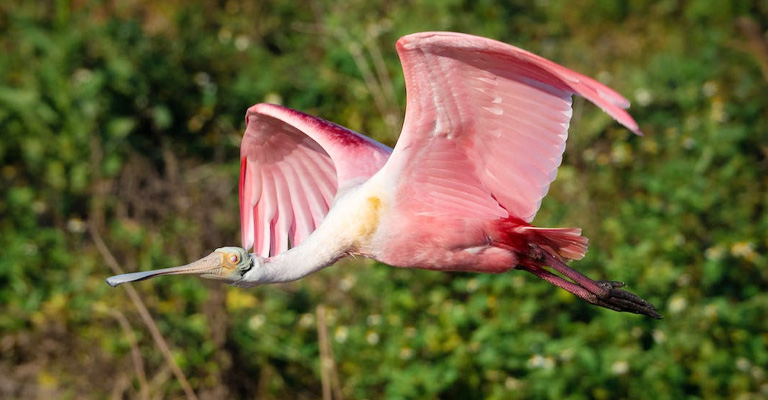
What Is The Natural Habitat Of Spoonbills?
Spoonbills are a group of aquatic birds that have long, flat, spoon-shaped bills. They live in various habitats across the world, where they can find shallow water to feed on small aquatic animals.
Here are some habitats where spoonbills can be found:
Marshes
Marshes are wetlands that are dominated by grasses and other herbaceous plants. They are often flooded by fresh or brackish water and provide food and shelter for many wildlife species.
Spoonbills can wade through the marshes and sweep their bills from side to side to catch insects, crustaceans, fish, and amphibians.
Wetlands

Wetlands are areas that are saturated with water, either permanently or seasonally.
They support a rich diversity of plants and animals and perform important ecological functions, such as filtering water, storing carbon, and preventing erosion. Spoonbills can find plenty of food and nesting sites in wetlands.
Mangroves
Mangroves are trees and shrubs that grow in tropical and subtropical coastal areas, where they can tolerate saltwater and tidal fluctuations.
They form dense forests that protect the coastline from storms, provide nursery habitats for fish and shellfish, and store large amounts of carbon.
Spoonbills can nest on mangrove islands and feed on the abundant aquatic life in the mangrove waters.
Swamps
Swamps are wetlands that are dominated by woody plants, such as trees and shrubs. They are usually found along rivers, lakes, or streams and have slow-moving or stagnant water.
They provide habitat for many species of birds, mammals, reptiles, amphibians, and fish. Spoonbills can roost and breed on swamp trees and feed on the aquatic organisms in the swamp water.
Lakes
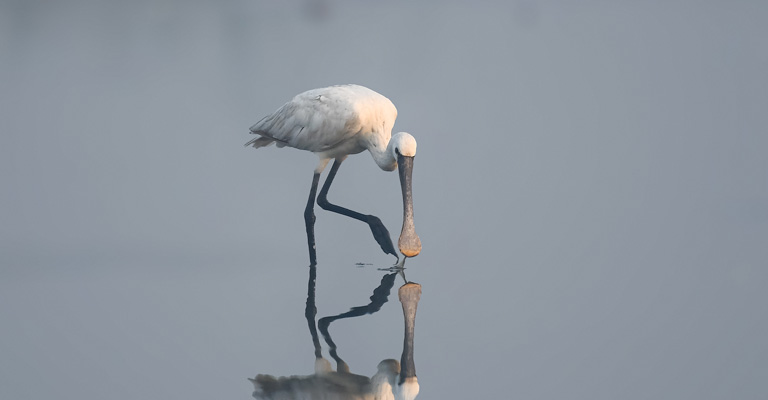
Lakes are large bodies of fresh or salt water that are surrounded by land. They vary in size, shape, depth, and productivity and support many aquatic and terrestrial ecosystems.
Spoonbills can feed on the edges of lakes, where they can find fish, snails, worms, and other prey.
Ponds
Ponds are small bodies of fresh or salt water that are isolated from larger water systems. They are usually shallow and have limited water circulation.
They harbour a variety of plants and animals, such as algae, aquatic plants, insects, crustaceans, molluscs, fish, amphibians, reptiles, birds, and mammals. Spoonbills can feed in ponds by dipping their bills in the water and filtering out their food.
Mudflats
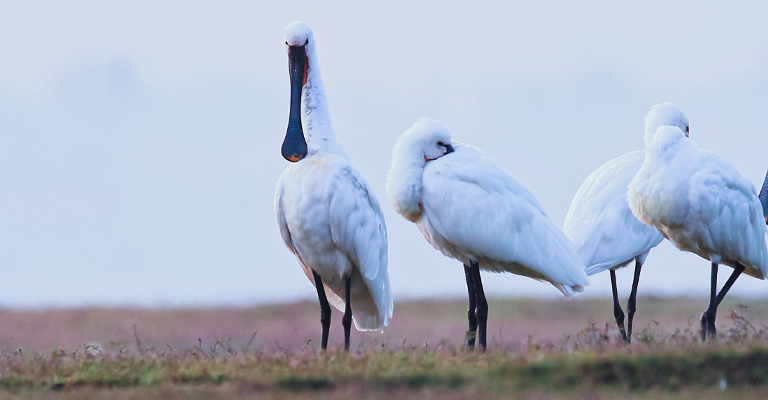
Mudflats are coastal areas that are exposed at low tide and covered at high tide. They are composed of fine sediments that are deposited by rivers or tides.
They are rich in organic matter and nutrients and support a diverse community of microorganisms, plants, and animals.
Spoonbills can feed on mud flats by probing their bills into the mud and extracting worms, crabs, shrimp, and other invertebrates.
Salt pans
Salt pans are shallow depressions that contain salt water or salt crystals. They are formed by the evaporation of seawater or inland water sources in arid or semi-arid regions.
They have high salinity and low biodiversity, but some species of algae, bacteria, fungi, plants, and animals can survive in them. Spoonbills can feed on salt pans by scooping up brine shrimp, brine flies, or other salt-tolerant organisms.
Rice fields
Rice fields are agricultural lands that are used to cultivate rice, a staple food crop for many people around the world. Rice fields are flooded with water during the growing season to provide optimal conditions for the rice plants.
They also create artificial wetlands that attract many wildlife species, especially birds. Spoonbills can feed on rice fields by taking advantage of the abundant food resources available in the water.
What Are The Characteristics Of A Spoonbill?
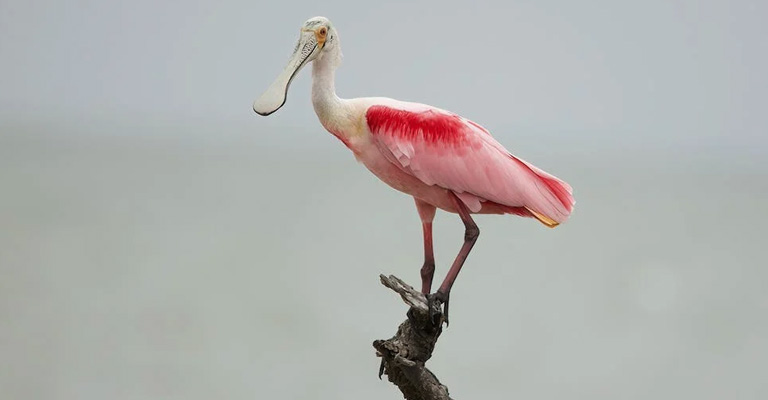
Certainly, here are nine characteristics of spoonbills, along with paragraph descriptions for each:
Distinctive Bill Shape:
Spoonbills are named after their unique bill, which is long, flat, and shaped like a spoon.
This specialized bill design is a key characteristic that sets them apart from other wading birds. It is used to sweep through shallow water to catch prey.
Coloration:
Most spoonbill species exhibit striking pink or reddish plumage, particularly during their breeding season.
Their vibrant colors are the result of their diet, which often includes crustaceans rich in pigments called carotenoids.
Large Size
Spoonbills are relatively large wading birds with a wingspan that can range from 2 to 4 feet (60 to 120 cm), depending on the species. Their size contributes to their impressive presence in wetland habitats.
Social Behavior
These birds are known for their social nature, often gathering in flocks, especially during foraging. Their communal behavior helps them find food more effectively and offers protection from predators.
Habitat Preference
Spoonbills primarily inhabit wetland ecosystems, including marshes, swamps, estuaries, and mudflats. They are well-adapted to shallow waters, where they can easily use their specialized bills to feed.
Feeding Habits
Spoonbills are filter feeders, using their bills to sweep through water and mud to capture prey such as small fish, crustaceans, and aquatic invertebrates. They swing their bills side to side, sifting food from the water.
Breeding Behavior
Spoonbills often exhibit elaborate courtship displays during the breeding season. They build nests in trees or shrubs near water and lay a clutch of eggs. Both parents share the responsibilities of incubating and raising the chicks.
Global Distribution
Spoonbills can be found on various continents, including North and South America, Europe, Africa, Asia, and Australia. Their presence is tied to suitable wetland habitats.
Conservation Status
While some species of spoonbills are of least concern, others face threats due to habitat loss, pollution, and disturbance.
Conservation efforts are in place to protect these birds and their vital wetland habitats.
Spoonbills are captivating birds with their distinct appearance, social behaviours, and unique feeding strategies.
They play a crucial role in maintaining the health of wetland ecosystems and continue to fascinate bird enthusiasts and researchers alike.
What Is The Use Of Spoonbill Beaks?
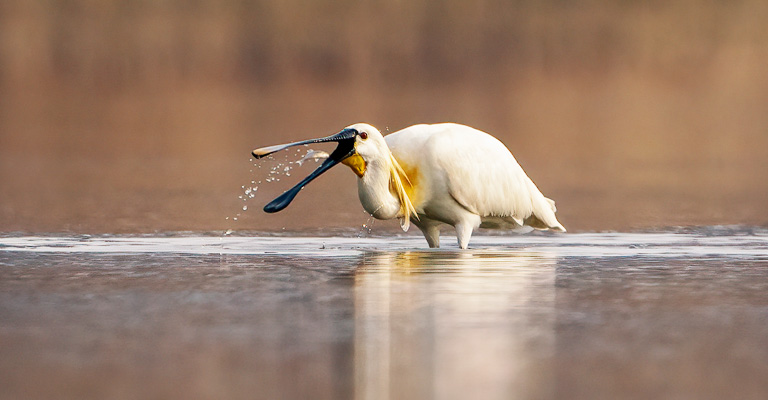
Spoonbill beaks are specialized for feeding on small aquatic animals in shallow water. Here are some amazing uses of spoonbill beaks:
Filtering
Spoonbill beaks have comb-like structures called lamellae along the edges, which help them filter out their prey from the water.
Sensing
Spoonbill beaks have nerve endings that help them sense their prey by touch or sight.
They can detect the slightest movement or vibration in the water and snap their beaks shut when they feel or see something edible.
Breathing
Spoonbill beaks have nostrils that are located near the base of the bill, which allow them to breathe while the bill is submerged in water.
This helps them feed for longer periods of time without lifting their heads.
Displaying
Spoonbill beaks have bare patches of skin around the bill and eyes, which can vary in colour from red to yellow to black, depending on the species.
The skin can also change colour during the breeding season to attract mates. Spoonbills also display their bills or feathers to convey different messages to other spoonbills or other water birds.
Nesting
Spoonbill beaks are used to build nests on trees, shrubs, or islands using sticks, reeds, or grasses. They also use their beaks to feed their chicks by regurgitating food into their mouths.
FAQ
Spoonbills inhabit wetland ecosystems around the world, including marshes, swamps, estuaries, and mudflats. They are commonly spotted near shallow waters with abundant food sources.
Spoonbills are adaptable and can thrive in both freshwater and saltwater habitats. They are often seen in brackish environments where rivers meet the sea, combining elements of both types.
No, while many species of spoonbills are associated with coastal areas, some can also be found in inland wetlands, lakes, and even flooded grasslands, depending on the species and their geographical distribution.
Spoonbills use their unique spoon-shaped bills to sweep through shallow water and mud, capturing aquatic invertebrates, small fish, and crustaceans. They swing their bills side to side, sifting out food from the water.
Wetlands provide essential feeding grounds for spoonbills due to their rich biodiversity.
These habitats offer abundant food sources and nesting sites. Conservation of wetlands is vital for preserving the natural habitat of spoonbills and maintaining overall ecosystem health.
Conclusion
In the vast tapestry of the natural world, the habitat of spoonbills emerges as a treasure trove of ecological significance.
From the serene salt marshes to the bustling mudflats, these avian inhabitants navigate and shape their environments.
As we appreciate the intricate relationships between spoonbills and their wetland homes, we recognize the importance of preserving these habitats.
Conservation efforts aimed at safeguarding these delicate ecosystems benefit not only the spoonbills themselves but also the myriad of other species that rely on these niches.
The natural habitat of spoonbills serves as a vivid reminder of the interconnectedness of life, emphasizing the need for responsible stewardship of our planet’s diverse landscapes.